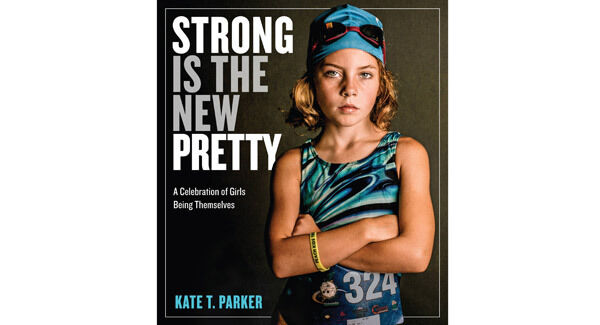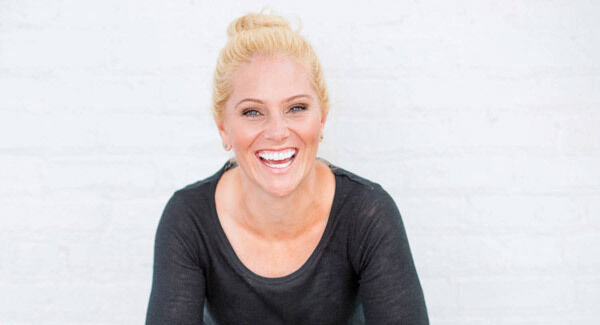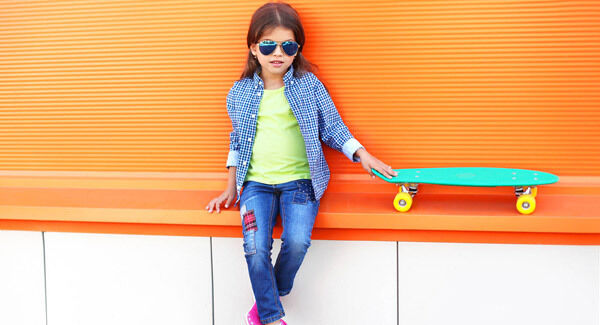Girl power: Self-belief is the jet fuel young girls need

SABRINA loves water polo. She’s six and can lift just one eyebrow and speak Farsi and play tennis. She can make people laugh by making funny faces.
Zohe is 10 and says when people think of girls, they think of make-up, heels and perfume.
“But girls aren’t all that. Girls are intelligent, ambitious, strong people and I’m proud to be one.”
Sabrina and Zohe are just two of 175 girls aged between five and 18 whose photos feature in Strong Is The New Pretty, A Celebration of Girls Being Themselves (€16.45, Workman Publishing).
Born out of a series that went viral in 2015, Kate Parker’s new collection shows girls are unstoppable.
The photos are of fierce, funny, adventurous, assertive, loud and creative, girls who are athletic and artsy, who are fighters and survivors; girls in a dance studio, wrapping up calloused feet; girls in football jerseys wearing eye black like war paint; girls showing off scars, messy hair, dirty feet; girls curled on couches, running through sprinklers or persisting through adversity.

Atlanta, Georgia-based Parker, a former Ironman, compiled the collection as an antidote to the myriad messages girls get that beauty is external, that it’s about body size, hairstyle or the ‘right’ clothes.
She wants to dismantle the fake, photo-shopped layers and get to an honest core: real power, strength and beauty come from within.
“I want to put out this little oasis of honesty about what girls look like and are interested in, to show power comes from pursuing what they love and being who they are,” says Parker.
Parker’s daughters feature in the book: Ella, 11, is on the cover and Alice, eight, “is in a bunch of times”.
She loves most the images of her girls where they’re being 100% themselves.
On the eve of a triathlon she’d trained for, Ella got cold feet.
“She said she couldn’t do it, she wasn’t ready. I knew she was. I took her to my studio and said ‘show me your toughest, fiercest face’. She did. I showed her the photo. I said ‘don’t you think that girl is ready for the triathlon’. She saw what I saw. She went out next day and nailed it.”

Publication of Parker’s collection coincided exactly with the launch of Why We March, Signs of Protest and Hope — Voices from the Women’s March after the Trump election, images powerfully portraying people raising their voices in hope, resistance and solidarity.
Women carry signs: ‘I will not go quietly back to the 1950s’ and ‘They tried to bury us but they didn’t know we were seeds’.
Yet, against this backdrop of bold displays of female power, other voices are urging us not to take our girls’ strength for granted.
Australian parenting guru Steve Biddulph has just published 10 Things Girls Need Most to Grow Up Strong and Free. He talks about a “battle for girlhood” and warns of “a harsh culture around girls now”.
In an interview with a British newspaper, he said: “Success, as defined by glittering career, affluent busy lifestyle and out-competing other kids in school is a living nightmare — it’s destroying mental health of almost every boy and girl caught up in it.”
Biddulph wants parents to get tough and stop under-parenting, dads should parent girls more and not just be “assistance mothers”, he wants to smash the damaging culture of “look-ism” around girls and he wants girls surrounded with loving, kind, wise, older women role models.

MEANWHILE, feminist Caitlin Moran has written an open letter to troubled teen girls, the ones she meets at book signings.
“I can tell instantly when you step up. The posture, something in your eyes — you the girls who are struggling right now. Some of you are hard and tense with overeating.
"Others, anorexic, feel like starving baby birds when I hug you. Maybe your arms are furious with criss-cross razor lines, or studs in your ear, nose, tongue, where you’ve tried to reclaim your bodies with the snap of a piercing gun.
"What do I say to you beautiful girls who are having the Bad Year, where you can’t remember why you were happy aged 12, and can’t imagine being happy at 21? What can I say in one minute?”
Moran tells these girls they must — right now and throughout their lives — learn how to build a girl.
So, how do you ‘build’ a girl? How do you maintain a girl in her strong true-self-inspired glory that she manifests aged five, eight, 10?
Like exuberant Alice in Strong Is The New Pretty: jumping high, playing leapfrog, saying ‘I try not to be scared when I learn a new trick. I just keep doing it and doing it until I get it’.
Parker knows the day will come when her daughters hit adolescence and suddenly their world will shake. In part, she compiled her book for what’s coming down the tracks.
“Part of my motivation is to remind my girls how amazing they used to think they were. There’s definitely a loss of confidence at that age [puberty] for whatever reason — hormones, boys, what others think of them.
"So you do everything you can to create that baseline of confidence before they get rattled, build them up so they’ll weather the storm, come out the other side, be what they’re meant to be.”
At this tween/teen threshold, girls can take a step back. Their physical activity levels go down, for example.
“A big bulk seems to drop off sport,” says Dr Kate Kirby, head of performance psychology at Sport Ireland Institute.
The 2012 Dáil na nÓg survey found girls almost twice as likely as boys to say negative body image interfered with activities like swimming.
“Research suggests they’re embarrassed about running around, being red-faced or sweating in front of people,” says Kirby.
And yet, the adolescent transition is normal, natural, a rite of passage we all experienced.
Dr Patrick Ryan, director of Clinical Psychology at UL and author of You Can’t Make Me, How to Get the Best Out of Your Teenager, points to a big realisation by teens — happening alongside their physical and brain development — sudden awareness of their place in family, peer group, school and community.
“They’re moving from closed family into the community. They become more aware of how they look and feel, how others see them. It’s like a selfie taken from inside — they experience it as picking up every tiny grain of their personality and their physical profile. The result is self-consciousness.”
Typical developmental experience — but how do we help our girls weather it when the tyranny of body image is greater than ever?
Adrienne Katz, author of Cyberbullying and E-Safety, sees society regressing in how we view women.

“Around 1999, we had a strong movement — helped by pop music — to promote strong girls. Think of the Spice Girls — empowered to do their thing. It was a moment when most messages were positive — an attitude of ‘can do’ girls. There was a common feeling among girls: ‘I can achieve my dreams. I am good enough’.”
Now, says Katz, there’s huge emphasis on body image, on female sexuality that pleases boys.
“Girls are being treated in ways we wouldn’t have believed in 1999. There’s this judging. It’s not a generous environment. It’s very critical, right when you feel most anxious about how you look.”
Counselling psychologist Sally O’Reilly has a speciality in adolescent/teen issues.
She meets girls who wish they were born in ‘her’ day — when ‘it was easier to talk to boys — there was no porn’.
Over the past five years, teen anxiety has centred on sexuality, she says.
“Girls are very concerned about males doing porn and resulting expectations on them.”
O’Reilly wants parents to stop saying ‘they grow up so fast these days — teenage girls are so sophisticated’.
“We’re dismissing their reality, copping out of taking responsibility. As adults with experience to draw on, we know porn involves fantasy, that sex in porn isn’t reflective of a real sex life.
"We assume teens know what’s real and what’s superficial, that girls know they’re not all supposed to be beautiful or doing oral sex at 13. But how do they know? We presume innate knowledge but a lot of them don’t know — we’re not telling them.”
O’Reilly urges dropping assumptions, having proper conversations with teens (boys too, she says, to keep girls strong, boys need to be strong), and teaching critical thinking about the difference between real-life sex and porn.
Mum-of-four Bláthnaid Ní Chofaigh has reared daughter Síle, 20, with “my eyes wide open to the world around me — I worked on her strength and individual personality”.
She advocates discussions on all topics “even if you don’t agree” and watching what your teens watch.”
When it comes to girls being strong, the RTÉ star distinguishes between confidence and self-esteem: “I’ve learned confidence. I have it down to a T. I could teach you how to walk into a room, how to do a certain flick of the hair. But my self-esteem is what it’s all about. My self-esteem is probably a lot lower than people think — it’s definitely a work in progress.”
Author Fay Weldon spoke controversially recently about girls’ self-esteem.
“Young women need classes in low self-esteem, not in high self-esteem. They’re brought up now to have an unrealistic view of themselves. It makes them live in a sort of bubble. They won’t listen to anybody else.”
Weldon has put her finger on something — we’re in touch with our inner power when we choose perseverance over pushy, grit over glamour, roots in reality rather than empty fame.
Tanith Carey, author of Girls, Uninterrupted, Steps for Building Stronger Girls in a Challenging World, distinguishes between over-inflated self-regard and self-worth.
“Self-worth isn’t ‘big-headedness’ — cocky, self-conscious, superficial confidence we see in so many young people. It’s not 24-hour-a-day full-on look-at-me that comes from conformity to today’s narrow definition of beauty.
"Self-worth is self-acceptance — feeling good about yourself most of the time. It’s ability to understand your feelings and [know] what makes you feel good and bad.”
Fostering self-worth isn’t about over-praise, says Carey.
“Trotting out ‘well dones’ for everything a child does — finishing breakfast, putting on a coat — devalues praise. Children know deep down they haven’t done anything exceptional. They stop trusting our evaluation.
"Instead we need to praise when they really do something challenging or new, so they know we’ve noticed it.”
Building a strong girl means making it clear from the start that physical beauty is only a small part of what she is. It’s not who she is.
It means prizing and developing the values endorsed in Strong Is The New Pretty: ‘Kindness is friends coming to cheer you up when you’re down’; ‘I always try new things — if I don’t like something, at least I know how it felt’; ‘I give it my all, even when nobody’s watching — my mom says this is what integrity is about.’
“Our messages about online safety are wrong. They emphasise all that can go wrong instead of teaching how to be strong and safe online. We need a problem-solving approach, rather than scare tactics.” — Adrienne Katz, author of Cyberbullying And E-Safety
“Achieving in different domains of life contributes to an overall sense of self-worth. The more sources of confidence girls have, the greater their self-belief. Teen years bring a struggle with identity sport gives a social outlet, a sense of belonging.” — Sports psychologist Dr Kate Kirby
“If children haven’t had an opportunity to test their problem-solving skills, it reduces resilience and makes them weaker. They have to experience bumps and falls along the way. In the playground, let an argument between friends run its course rather than stopping it two seconds in.” — Dr Patrick Ryan, director of Clinical Psychology at UL
“Let them know their best is in a constant state of flux. Embrace this as fact. They don’t have to beat themselves up. True confidence doesn’t assume constant success.” — Counselling psychologist Sally O’Reilly.
“Social media has allowed young people think they’re experts on everything before they are. There’s nothing wrong with having opinions as a young person — but they must be based on experience, fact and listening to other people.” — Author Tanith Carey










